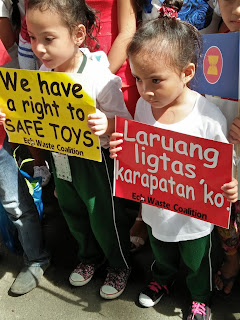EcoWaste Coalition Campaigns for Children’s Right to Safe Games and Toys to Play With ahead of the ASEAN Summit
As presidents, prime ministers and
other influential leaders from the government and the industry converge in the
Philippines for the 31st ASEAN Summit and related
meetings, a group of young children, along with their parents and teachers,
gathered in Quezon City on Sunday morning to tackle an issue that may not even
get cited in any of the conference declarations and statements: the right of
children to safe games and toys to play with.
At the launch of the EcoWaste Coalition’s annual advocacy for safe and
non-toxic toys, over 150 children joined the fun and music-filled event to call
attention to the importance of protecting children from unsafe playthings in
the ASEAN and the domestic marketplace.
The event coincided with two historic milestones: the 3rd
anniversary of the adoption by the Commission of Human Rights of “The People’s
Right to Chemical Safety: A 15-Point Human Rights Agenda” on November 14, and
the 28th anniversary of the adoption of the UN Convention on
the Rights of the Child on November 20.
“Through our event today, we hope to draw society’s support to efforts aimed at
ensuring children’s access to safe and non-hazardous playthings that will
contribute to their full intellectual, emotional and physical development,
especially during their formative years,” explained Thony Dizon, Chemical
Safety Campaigner, EcoWaste Coalition.
“Children will easily fall victims to the hidden dangers of low-quality and
improperly labeled toys, hence the need to protect them from such dangers that
are often unnoticeable to the naked eye,” he said.
"We seek greater cooperation among ASEAN member states
and their dialogue partners, particularly China, to safeguard all children from
the illegal and unethical trade of toys that are not guaranteed safe for
children's use," he added.
During the event, Atty. Vic Dimagiba, President of Laban Konsyumer, Inc.
stressed the importance of enforcing R.A. 10620, or the Toy and Game Safety
Labeling Act of 2013.
“Over four years have lapsed since the law was approved and we wonder if its
Implementing Rules and Regulations will ever see the light of day this
year. We have to push for the implementation of this law, which imposes
special labeling for games and toys to protect children against potential
hazards to their health and safety,” said Dimagiba, a former Department of
Trade and Industry undersecretary.
Pediatric toxicologist Dr. Bessie Antonio warned that toys that have not
undergone quality and safety assessment may contain health-damaging chemicals
such as cadmium, lead, mercury, phthalates and other hazardous substances.
“Children are exposed to these toxic chemicals that can leach out when they put
toys inside their mouth or suck toys containing such substances. Chronic
exposure to these chemicals even at low levels may put the growth and
development of children at risk,” said Antonio, a doctor at
the East Avenue Medical Center.
Chronic exposure to lead even at low doses, for instance,
can harm a child’s health over time, affect brain development and result to
decreased intelligence as measured by IQ tests, reduced school performance and
behavioral problems.
Aside from chemical risk, the EcoWaste Coalition
identified other common hazards in toys that consumers should be cautious
about, including loose or small parts that may be swallowed and cause breathing
difficulties or choking; pointed or sharp edges that may injure the eyes
or cause cuts and grazes; and cords longer than 12 inches that cause
strangulation.
With Christmas toy shopping spree
fast approaching, the EcoWaste Coalition came up with an eight-point “Santa’s
Guide for Safe Toys.” Safe toys must be 1) age-appropriate, 2) well-made,
3) no small parts, 4) string shorter than 12 inches, 5) injury-free, 6) not
coated with lead paint, 7) not made up of polyvinyl chloride (PVC) plastic, and
8) duly labeled and registered.
During the event, the EcoWaste Coalition screened toys brought by the
participating children for toxic metals using an X-Ray Fluorescence (XRF)
device.
Among the participants were children, parents and teachers from Buklod
Kabataan, ROTCHNA Daycare Center, and the San Vicente Elementary School.
-end-










Comments